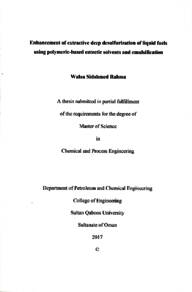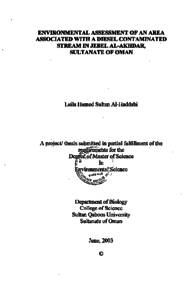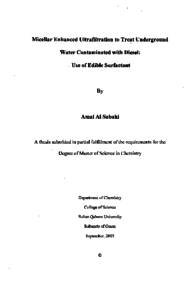وثيقة
Enhancement of extractive deep desulfurization of liquid fuels using polymeric-based eutectic solvents and emulsification
الناشر
Sultan Qaboos University
ميلادي
2017
اللغة
الأنجليزية
الموضوع
الملخص الإنجليزي
One of the long-standing problems facing the petroleum refining industries is the presence of sulfur compounds in fuel oils. Sulfur causes many technical problems during refining and commercial use of fuel oil. Several novel deep desulfurization techniques have been utilized to achieve ultra-deep desulfurization. Among all the developed desulfurization technologies, extractive desulfurization (EDS) has shown promising results toward the removal of sulfur compounds from liquid fuels. The key to effective EDS processes is to find a relevant solvent with high affinity to sulfuric compounds. To minimize the economic and environmental effects of convectional solvents, recent studies have aimed to the development of sustainable alternative solvents. In this work, the extractive desulfurization of dibenzothiophene (DBT) and thiophene were investigated using a new tetrabutyl ammonium bromide (TBAB): Polyethylene glycol (PEG) deep eutectic solvents. The quaternary ammonium salt tetrabutyl ammonium bromide (TBAB) was used as the organic salt and Polyethylene glycol having average molecular weights of 200 and 600 (PEG200 and PEG 600) as hydrogen bond donors (HBD). The Central Composite Design (CCD) statistical approach was employed to analyze the experimental results and optimize the operating conditions. The solvents showed high sulfur removal efficiency of DBT and thiophene in simulated fuel. Using a solvent to fuel volume ratio of 1:1 (Vdes/V Fuel = 1:1), the extraction efficiency reached 82.40 % and 62.16% for DBT and thiophene respectively within the first extraction stage and at room conditions. Effect of solvent to volume ratio, time, temperature, initial concentration and speed of mixing on extraction efficiency were investigated. By increasing the solvent volume ratio (Vpes/V Fuel = 2:1) the extraction efficiency can reach up to 91.17 %and 77.83% for DBT and thiophene respectively. The results showed that increasing the speed of mixing has a great influence on the extraction efficiency.
The deep desulfurization of the simulated fuel was also carried out in multiple extraction stages. Performed experiments showed that 100% (DBT) and 95.15% (Thiophene) extraction efficiencies were achieved after three extraction stages only using a volumetric ratio of Vdes/V Fuel = 1:1. Optimal performance was achieved using two extraction stages with a volumetric ratio of Vpes/V Fuel = 3:1. Efficiencies of 100% and 97.79 % were achieved using these conditions. These represent the minimum number of extraction cycles so far reported using quaternary ammonium based eutectic solvents for the EDS process. Moreover, the desulfurization of real commercial diesel was studied and 46.75 % total sulfur removal from the diesel was achieved. Up to our knowledge, very little work has been reported on the effect of emulsification in the fuel-DES mixtures in the presence of an emulsifier. For this reason, the extractive desulfurization of dibenzothiophene (DBT) and thiophene was investigated in such systems. Furthermore, the effect of different process parameters such as temperature, speed of mixing, extraction time, and surfactants concentration on the emulsification extraction process were investigated. Surfactants addition to these systems showed noticeable enchantment on the extraction efficiency. Adding 10% of SDS to the (DES 1/fuel) mixture led to 2% increase on extraction efficiency of DBT and 8% increase on the extraction efficiency of thiophene. Additionally, the addition of different types of glycols was also investigated. These glycols were introduced to the mixture in different proportions and the performance of the extraction process follow the order: PEG 400 > PEG 200 > Dipropylene glycol > Triethylene glycol > Diethylene glycol. Finally, DESs were successfully regenerated and reused five times without significant loss of solvent activity. This is a very valuable and desirable result from an industrial point of view.
المجموعة
URL المصدر
الملخص العربي
يعد وجود الكبريت في منتجات الوقود المختلفة أحد أكبر المشاكل و المصاعب التي تواجه مصافي البترول. يسبب الكبريت العديد من المشاكل التقنية أثناء عملية التصفية والاستهلاك التجاري للوقود. لقد تم استخدام العديد من التقنيات الصناعية الحديثة لإزالة الكبريت والحصول على إزالة فائقة لهذه المركبات الكبريتية. تعد إزالة الكبريت بالاستخلاص واحدة من التقنيات التي تم استخدامها وقد أظهرت هذه التقنية نتائج واعدة في إزالة المركبات الكبريتية من الوقود السائل. يعد اختيار مذيب فعال لهذه المركبات أحد أهم العوامل المؤثرة في نجاح تقنية إزالة الكبريت بالاستخلاص. هنالك العديد من الدراسات التي أجريت مؤخرا هدفت للحصول على مذيبات بديلة أكثر استدامة للتقليل من الأثار الجانبية المصاحبة للمذيبات التقليدية. تم في هذا العمل دراسة استخلاص كل من الدايبنزوثايوفين و الثايوفين باستخدام مذيب فعال صديق للبيئة متكون من: الملح الرباعي تترابيوتل امونیوم بروماید و بولي ايثلين جلايكول .
ملح الأمونيوم الرباعي تم استخدامه كملح عضوي في حين تم استخدام إثيلين جلايكول كمانح للرابطة الهيدروجينية. التصميم المركزي المركب تم توظيفه لتحليل نتائج التجارب وتحسين ظروف العملية. و قد اظهرت المذيبات إزالة فعالة لمركبات الكبريت التي تم إجراء الدراسة عليها باستخدام الوقود المحاکی.
تم الحصول على نسبة إزالة لكل من الدايبنزوثايوفين و الثايوفين بمقدار 40. 82 % و 16 . 62 % عالى التوالي وذلك باستخدام المذيب 1 وبنسبة حجمية بقيمة 1 : 1 (مذيب : وقود محاکی) وبدرجة حرارة الغرفة في حين أن إستخدام المذيب 2 في نتج عن إزالة بنسبة و 74. 75 % و % 06 . 53 من الدايبنزوثايوفين و الثايوفين على التوالي كمرحلة أولى للاستخلاص. تم دراسة تأثير كل من النسبة الحجمية, الوقت الحرارة, التركيز الإبتدائي و سرعة الخلط على الاستخلاص. زيادة النسبة الحجمية للمذيب بنسبة 1: 2 أدت إلى رفع نسبة الإستخلاص إلى 17. 91 % و 83. 77 % للدايبنرزوثايوفين و الثايوفين على التوالي. النتائج أظهرت أيضا أن رفع سرعة الخلط له تأثير كبير على نسبة الإستخلاص. تم تطبيق الإزالة الفائقة المركبات الكبريت من الوقود المحاكي أيضا على مراحل متعددة. وقد أظهرت النتائج إستخلاص 100% من الدايبنزوثايوفين و 15 . 95 % من الثايوفين وذلك بعد ثلاث مراحل فقط و باستخدام نسبة حجمية بلغت 11 بينما تم إزالة 100% للدايبنزوثايوفين و 79 . 97 % للثايوفين بعد مرحلتين من الإستخلاص باستخدام نسبة حجمية بلغت 1 : 3, و هو ما يعتبر أقل عدد مراحل تم التوصل إليه باستخدام المذيبات الداخل في تكوينها ملح الأمونيوم الرباعي . تم أيضا دراسة إزالة المركبات الكبريتية من الديزل التجاري و الحصول على إزالة بنسبة 75. 46 % لمجمل المركبات الكبريتية المتواجدة في الديزل. من جهة أخرى, ركزت الدراسة على الإستحلاب و التجميع الذاتي المتواجد في المذيب و استخلاص المركبات الكبريتية.
أظهرت النتائج تحسنا ملحوظا في الإستخلاص عند إضافة المستحلبات لهذه المذيبات. حيث أن إضافة 10 % من هذه المركبات الى خليط المذيب و الوقود حسن الإستخلاص بنسبة 3% للدايبنزوثايوفين و 10% للثايوفين. و في نفس السياق تم إضافة بوليمرات مختلفة لخليط المذيب و الوقود. وقد أظهرت هذه المركبات التسلسل التالي من حيث الأداء: بولي إثيلين جلايكول 400 > بولي إثيلين جلايكول 200 > بروبلين جلايكول الثنائي > إثيلين جلايكول الثلاثي > إثيلين جلايكول الثنائي
ختاما، تم تنقية وإعادة استخدام هذه المذيبات الفائقة الصديقة للبيئة خمس مرات بدون أي انخفاض ملحوظ في كفاءتها وهو ما يعتبر ذا أهمية بالغة ومرغوبة به من الناحية الصناعية.
ملح الأمونيوم الرباعي تم استخدامه كملح عضوي في حين تم استخدام إثيلين جلايكول كمانح للرابطة الهيدروجينية. التصميم المركزي المركب تم توظيفه لتحليل نتائج التجارب وتحسين ظروف العملية. و قد اظهرت المذيبات إزالة فعالة لمركبات الكبريت التي تم إجراء الدراسة عليها باستخدام الوقود المحاکی.
تم الحصول على نسبة إزالة لكل من الدايبنزوثايوفين و الثايوفين بمقدار 40. 82 % و 16 . 62 % عالى التوالي وذلك باستخدام المذيب 1 وبنسبة حجمية بقيمة 1 : 1 (مذيب : وقود محاکی) وبدرجة حرارة الغرفة في حين أن إستخدام المذيب 2 في نتج عن إزالة بنسبة و 74. 75 % و % 06 . 53 من الدايبنزوثايوفين و الثايوفين على التوالي كمرحلة أولى للاستخلاص. تم دراسة تأثير كل من النسبة الحجمية, الوقت الحرارة, التركيز الإبتدائي و سرعة الخلط على الاستخلاص. زيادة النسبة الحجمية للمذيب بنسبة 1: 2 أدت إلى رفع نسبة الإستخلاص إلى 17. 91 % و 83. 77 % للدايبنرزوثايوفين و الثايوفين على التوالي. النتائج أظهرت أيضا أن رفع سرعة الخلط له تأثير كبير على نسبة الإستخلاص. تم تطبيق الإزالة الفائقة المركبات الكبريت من الوقود المحاكي أيضا على مراحل متعددة. وقد أظهرت النتائج إستخلاص 100% من الدايبنزوثايوفين و 15 . 95 % من الثايوفين وذلك بعد ثلاث مراحل فقط و باستخدام نسبة حجمية بلغت 11 بينما تم إزالة 100% للدايبنزوثايوفين و 79 . 97 % للثايوفين بعد مرحلتين من الإستخلاص باستخدام نسبة حجمية بلغت 1 : 3, و هو ما يعتبر أقل عدد مراحل تم التوصل إليه باستخدام المذيبات الداخل في تكوينها ملح الأمونيوم الرباعي . تم أيضا دراسة إزالة المركبات الكبريتية من الديزل التجاري و الحصول على إزالة بنسبة 75. 46 % لمجمل المركبات الكبريتية المتواجدة في الديزل. من جهة أخرى, ركزت الدراسة على الإستحلاب و التجميع الذاتي المتواجد في المذيب و استخلاص المركبات الكبريتية.
أظهرت النتائج تحسنا ملحوظا في الإستخلاص عند إضافة المستحلبات لهذه المذيبات. حيث أن إضافة 10 % من هذه المركبات الى خليط المذيب و الوقود حسن الإستخلاص بنسبة 3% للدايبنزوثايوفين و 10% للثايوفين. و في نفس السياق تم إضافة بوليمرات مختلفة لخليط المذيب و الوقود. وقد أظهرت هذه المركبات التسلسل التالي من حيث الأداء: بولي إثيلين جلايكول 400 > بولي إثيلين جلايكول 200 > بروبلين جلايكول الثنائي > إثيلين جلايكول الثلاثي > إثيلين جلايكول الثنائي
ختاما، تم تنقية وإعادة استخدام هذه المذيبات الفائقة الصديقة للبيئة خمس مرات بدون أي انخفاض ملحوظ في كفاءتها وهو ما يعتبر ذا أهمية بالغة ومرغوبة به من الناحية الصناعية.
قالب العنصر
الرسائل والأطروحات الجامعية




